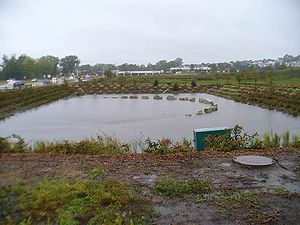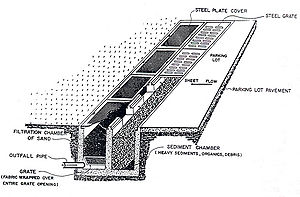
Types of sand (media) filters
Sand filters are also referred to as filtration basins, filter systems, first-flush filtration, or media filtration systems. The following types of sand filter systems are appropriate for Minnesota, depending upon project scale and site conditions.
Contents
Surface sand filter
For a surface sand filter, a flow splitter is used to divert runoff into an off-line sedimentation chamber. The chamber may be either wet or dry, and is generally used for Pretreatment. Runoff is then distributed into the second chamber, which consists of a sand filter bed (~18 inches) and temporary runoff storage above the bed. Pollutants are trapped or strained out at the surface of the filter bed. The filter bed surface may have a sand or grass cover. A series of perforated pipes located in a gravel bed collect the runoff passing through the filter bed, and return it to the stream or channel at a downstream point. If underlying soils are permeable, and groundwater contamination unlikely, the bottom of the filter bed may have no lining, and the filtered runoff may be allowed to infiltrate. See Computer-aided design and drafting (CAD/CADD) drawings for design drawing.
Iron enhanced sand filter
Iron-enhanced sand filters (IESFs) are filtration Best Management Practices (BMPs) that incorporate filtration media mixed with iron. The iron removes several dissolved constituents, including phosphate, from stormwater. Iron-enhanced sand filters may be particularly useful for achieving low phosphorus levels needed to improve nutrient impaired waters. Iron-enhanced sand filters could potentially include a wide range of filtration BMPs with the addition of iron; however, iron is not appropriate for all filtration practices due to the potential for iron loss or plugging in low oxygen or persistently inundated filtration practices.
Because of the widespread use of this practice, we have separate pages on design, operation and maintenance, and crediting.
- Iron enhanced sand filter (Minnesota Filter) - main page for IESFs
- Overview for iron enhanced sand filter
- Design criteria for iron enhanced sand filter
- Operation and maintenance of iron enhanced sand filter
- Calculating credits for iron enhanced sand filter
Underground sand filter
The underground sand filter was adapted for sites where space is at a premium. In this design, the sand filter is placed in a 3 chamber underground vault accessible by manholes or grate openings. The vault can be either on-line or off-line in the storm drain system. The first chamber is used for Pretreatment and relies on a wet pool as well as temporary runoff storage. It is connected to the second sand filter chamber by an inverted elbow, which keeps the filter surface free from trash and oil. The filter bed is 18 inches in depth and may have a protective screen of gravel or permeable geotextile to limit clogging. During a storm, the water quality volume is temporarily stored in both the first and second chambers. Flows in excess of the filter’s capacity are diverted through an overflow weir. Filtered runoff is collected, using perforated underdrains that extend into the third “overflow” chamber. See Computer-aided design and drafting (CAD/CADD) drawings for design drawing.
Perimeter sand filter
The perimeter sand filter consists of two parallel trench-like chambers that are typically installed along the perimeter of a parking lot (See schematic of Delaware sand filter). Parking lot runoff enters the first chamber, which has a shallow permanent pool of water. The first trench provides pre-treatment before the runoff spills into the second trench, which consists of a sand layer (12 inches to 18 inches). During a storm event, runoff is temporarily ponded above the normal pool and sand layer, respectively. When both chambers fill up to capacity, excess parking lot runoff is routed to a bypass drop inlet. The remaining runoff is filtered through the sand, and collected by underdrains and delivered to a protected outflow point. See Computer-aided design and drafting (CAD/CADD) drawings for design drawing.
Other filters not approved for Minnesota
The following filters are not recommended for use in Minnesota due to high probability of failure under cold climate conditions. They are included here for informational purposes only.
Organic filter
The organic filter functions in much the same way as the surface sand filter, but uses leaf compost or a peat/sand mixture as the filter media instead of sand (compost and peat should not be used when the target pollutant for removal is a dissolved nutrient. The organic material enhances pollutant removal by providing adsorption of heavy metals. In an organic filter, runoff is diverted with a flow splitter into a pre-treatment chamber, from which it passes into one or more filter cells. Each filter bed contains a layer of leaf compost or the peat/sand mixture, followed by a filter fabric and perforated pipe and gravel. Runoff filters through the organic media to the perforated pipe and ultimately to the outlet. The filter bed and subsoils can be separated by an impermeable polyliner to prevent movement into groundwater.
It is HIGHLY RECOMMENDED that the facility be actively managed to keep it dry before it freezes in the late fall.
Pocket filter
Pocket sand filters are intended as an inexpensive variation of a sand filter where sediment loads do not warrant a sedimentation chamber and can suffice with a grass filter strip and a plunge pool. The filter bed is comprised of a shallow basin containing the sand filter medium. The filter surface is a layer of soil and a grass cover. In order to avoid clogging the filter has a pea gravel “window” which directs runoff into the sand and a cleanout and observation well. Typically the filtered runoff is allowed to exfiltrate to ground water, although underdrains may be needed if the soils are not suitably permeable.
Submerged gravel wetland
Submerged gravel filters consist of a series of cells that are filled with crushed rock or gravel. The standpipe from each cell is set at an elevation that keeps the rock or gravel submerged. Wetland plants are rooted in the media, where they can directly take up pollutants. The anaerobic conditions on the bottom of the filter can foster the de-nitrification process. Submerged gravel wetlands are not recommended for stormwater quality in cold climate conditions, although they do have been used in Minnesota for effluent polishing of wastewater.
Related pages
- Overview for sand (media) filters
- Types of sand (media) filters
- Design criteria for sand (media) filters
- Construction specifications for sand (media) filters
- Assessing the performance of sand (media) filters
- Operation and maintenance of sand (media) filters
- Calculating credits
- Cost-benefit considerations for sand (media) filters
- References for sand (media) filters
- Requirements, recommendations and information for using sand filter as a BMP in the MIDS calculator
- Links to detail images
- Perimiter sand filter details: File:Perimeter Sand Filter PERIMETER SAND FILTER DETAILS (1).pdf
- Surface sand filter: File:SURFACE Sand Filter3 Surface sand filter (1).pdf
- Underground sand filter: File:UNDERGROUND SAND FILTER Layout2 (1).pdf
- Sand filter and iron enhanced sand filter photos
- Sand filter and iron enhanced sand filter tables
- Fact sheet for filtration (Includes vegetated filters)
This page was last edited on 31 January 2023, at 18:59.

